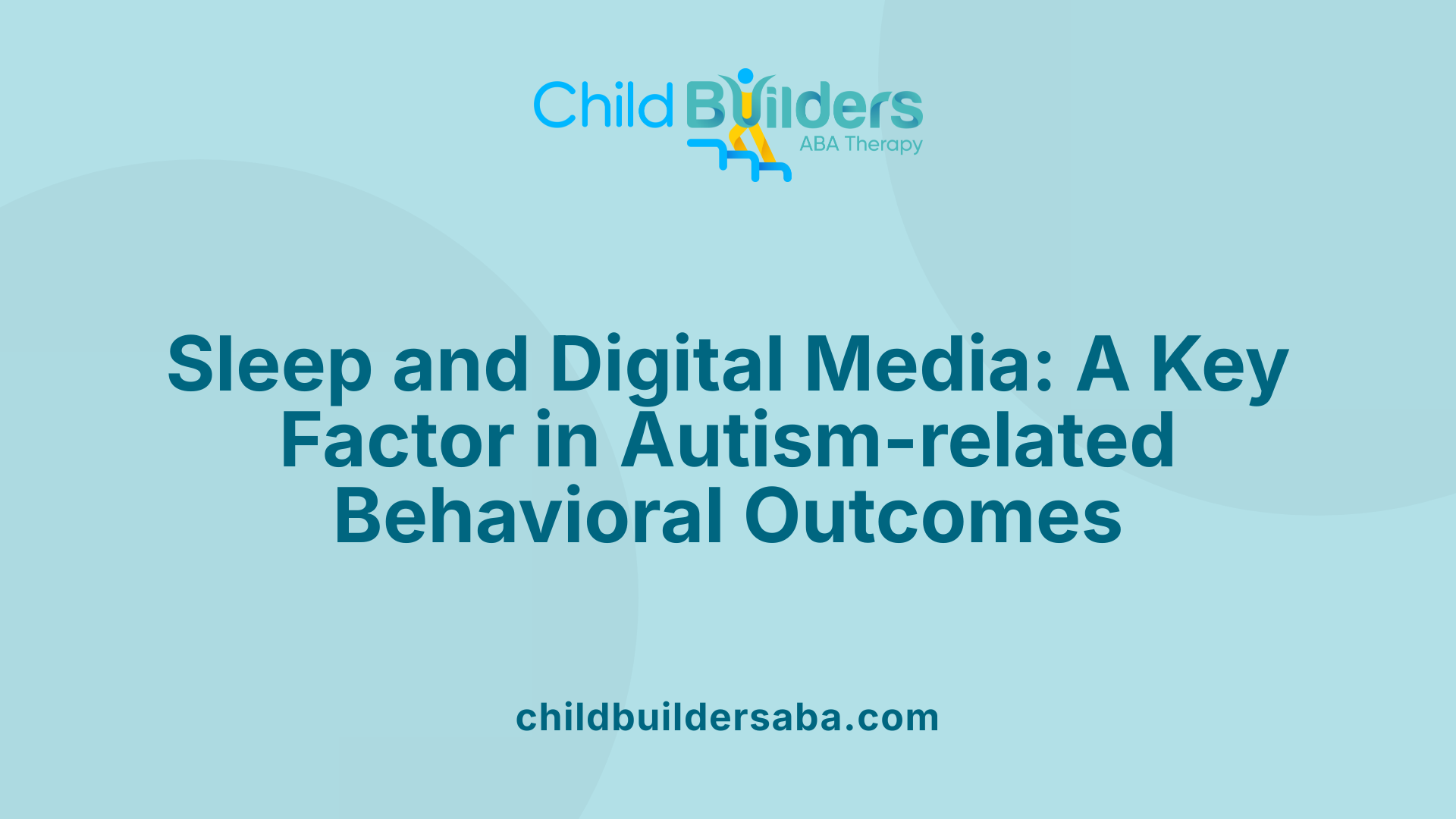Screen Time and Autism

Understanding the Evidence and Implications
In recent years, growing concerns have emerged about the impact of digital media on early childhood development, particularly in relation to autism spectrum disorder (ASD). While research explores various associations between screen time and autistic traits, consensus remains cautious, emphasizing the importance of nuanced interpretations rather than simplistic causation. This article delves into scientific findings, examining potential risks, benefits, and management strategies, to provide a comprehensive understanding of how screen exposure intersects with autism.
Early Screen Exposure and ASD Risk: What Does the Evidence Say?

How does screen time affect children with autism, including behavioral and developmental outcomes?
Excessive screen time in children with autism is associated with a range of negative behavioral and developmental outcomes. Studies show that increased use of screens correlates with heightened autistic symptoms, including sensory overload, repetitive behaviors, and challenges in communication and social interaction. Longer durations of screen exposure are also linked to more severe sensory sensitivities and delays in language development.
Research suggests that reducing screen time can lead to noticeable improvements in core autism symptoms, social engagement, and adaptive skills. Conversely, excessive media use may worsen sensory issues and hinder progress in speech, emotional regulation, and socialization. It is crucial for caregivers to tailor screen habits carefully, favoring activities that promote face-to-face interaction, play, and social bonding.
While screens can provide benefits—such as calming effects through predictable content and visual stimuli—they should be used thoughtfully. Balanced use, combined with active parent involvement, supports better developmental and behavioral outcomes.
What is the impact of early and prolonged screen exposure on autism spectrum disorder development?
Early and prolonged exposure to screens during critical developmental periods, particularly within the first two years of life, has been linked to atypical sensory processing and neurodevelopmental issues associated with autism spectrum disorder (ASD). Studies indicate that children exposed to high levels of screen time by age one have increased chances of exhibiting behaviors such as sensation seeking, avoidance, and low registration of sensory inputs.
This atypical sensory processing can lead to behavioral challenges, including irritability, hyperactivity, and social difficulties characteristic of ASD. Moreover, excessive early screen exposure may influence brain organization, impacting neural pathways related to language, social cognition, and emotional regulation.
Although causality cannot be conclusively established yet, evidence suggests that limiting digital media—especially in infants and toddlers—could reduce the risk or severity of sensory and developmental abnormalities linked to ASD.
Are there risks and benefits associated with screen use in children at risk of autism?
Children at risk of autism face a delicate balance regarding screen use. On one side, excessive exposure—more than three hours daily—has been associated with higher scores on autism screening tools, delays in language, and difficulties with social interactions. Prolonged screen time can exacerbate sensory sensitivities, sleep disturbances, and behavioral issues.
On the other hand, digital media offers potential benefits when used appropriately. High-quality, supervised content can support early language acquisition, literacy, and communication skills. Screens can serve as tools for social engagement, especially for children with social-emotional challenges or those who find face-to-face interactions overwhelming.
To maximize benefits and minimize risks, caregivers are encouraged to set limits, choose suitable content, engage actively with children during media use, and balance screen time with interactive play and social activities.
What factors mediate the relationship between screen time and autism development, such as sleep issues?
Sleep problems are a major mediator between screen time and autism-related behaviors. Increased screen use, particularly before bedtime, can cause sleep disturbances like delayed sleep onset, reduced sleep duration, and poor sleep quality. These sleep issues can worsen behavioral symptoms and may amplify autistic traits such as irritability and hyperactivity.
Other mediating factors include parent-child interaction levels and parental restrictions. Research shows that children with less parental oversight or fewer boundaries around screen use tend to experience greater negative impacts.
Biological factors also play a role; in children with autism, disruptions in melatonin production and circadian rhythms can make them more susceptible to sleep disturbances induced by screen exposure.
Overall, addressing sleep hygiene and establishing routines limiting screen use before sleep can help mitigate some of these mediating effects.
What are the current guidelines and management strategies for screen use among children with autism?
Guidelines for screen use in children—including those with autism—advocate for a tailored, balanced approach. For children under 18 months, screen time should be minimal, limited mainly to video chatting with parents. Between ages 2 and 5, recreational screen time should not exceed one hour daily, emphasizing high-quality, educational content.
For children aged 6 and older, recommendations generally suggest limiting recreational screen time to no more than two hours per day. It is important to include active parental involvement, monitor online activity, and encourage alternative activities such as outdoor play, social interactions, and hands-on learning.
Implementing structured routines, modeling healthy digital habits, and involving families in regular review help manage screen exposure effectively. The goal is to ensure that digital media support social, emotional, and developmental growth rather than hinder it.
What is the current scientific consensus on the relationship between screen time and autism?
The prevailing scientific view is that there is no conclusive evidence to suggest that screen time causes autism. Although early screen exposure has been associated with increased autism-like symptoms on screening tests such as the Modified Checklist for Autism in Toddlers (MCHAT), these associations do not prove causality.
Autism is primarily a genetically driven neurodevelopmental disorder, with rising diagnosis rates attributed to changes in diagnostic practices, increased screening, and environmental factors like prematurity.
Research indicates that while excessive screen time might influence brain organization and sensory processing, the relationships are complex and bidirectional. Children with autism often spend more time on screens due to social and communication challenges, not necessarily because screens induce autism.
Overall, experts recommend focusing on supportive environments, balanced digital use, and early intervention rather than viewing screen time as a direct cause of autism.
Implications for Parents and Caregivers
In summary, while evidence links early and excessive screen time to some autism-like traits and developmental challenges, it is important to understand that current research does not establish causality. Autism is a complex, neurodevelopmental condition with strong genetic components. Nonetheless, moderating screen exposure, especially during critical periods of brain development, coupled with promoting active social engagement and quality interactions, remains a practical approach to support optimal development. Parents, caregivers, and educators should stay informed about evolving guidelines and adapt strategies to foster healthy media habits, ultimately aiming for environments that nurture social, emotional, and cognitive growth.
References
- Early Screen-Time Exposure and Its Association With Risk of ...
- Screen Time Before 2 Years of Age and Risk of Autism at 12 Years ...
- Early Childhood Screen Time, Brain Development, and Autism - AAP
- Autism and Screen Time: A Must-Know Connection for Parents
- Screen Time and Autism Spectrum Disorder: A Systematic Review ...
- Neurodivergent Kids and Screen Time - Child Mind Institute
- Autism and screen time: Are they related? - Norton Children's
- Changes in autism symptoms associated with screen exposure
- Screen Time and Social Engagement in Early Childhood Development



.jpg)

































































































